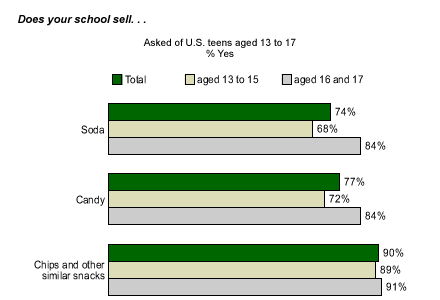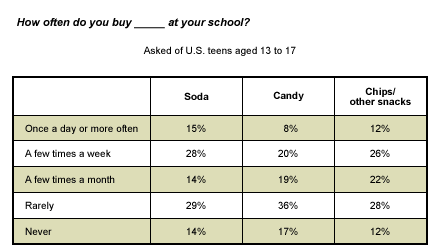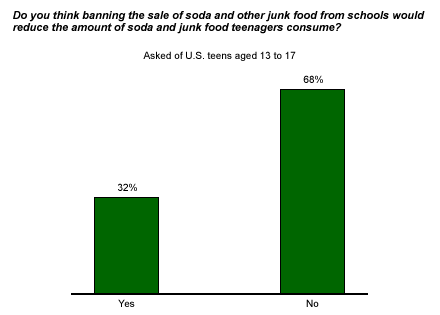Legislation that would ban the sale of junk food in New Jersey's public elementary and middle schools made it through committee last week and may soon be up for vote in the state assembly. New Jersey joins a growing number of states throughout the country attempting to address the nation's obesity crisis by controlling the sale of soda and junk food in schools. About two dozen states reportedly are contemplating bans or limits on vending machine goodies, while roughly 20 already confine access to junk food to after lunch.
Despite these efforts, most teens still can readily purchase soda and junk food in their schools, according to a recent ║┌┴¤═° Youth Survey*. Three in four teens (aged 13 to 17) report being able to purchase soda or candy at school, and 9 in 10 teens can purchase chips or other similar snacks. Reports of the availability of junk food increase markedly with age, suggesting that it is more easily accessible in high schools than it is in middle schools. Among 13- to 15-year-olds, 68% report being able to purchase soda and 72% can purchase candy, but 84% of 16- and 17-year-olds say they are able to buy both such products at school.

Eating nutritionally poor high-sugar drinks and foods has been tied to the rise in obesity among children. The U.S. Centers for Disease Control and Prevention (CDC) finds that the number of overweight children is increasing at an alarming rate in the United States, tripling over the past two decades. Among children and teens aged 6 to 19, 15% are overweight, according to the CDC's 1999-2000 data.
According to the ║┌┴¤═° Youth Survey, 15% of teenagers purchase soda daily at school, while 28% purchase it a few times a week. These figures do not include teens who purchase or drink it outside of school.

"Soft drinks are the No. 1 beverage consumed by Americans, but water is now a distant No. 2," says Dr. Mary McKenna, a health scientist at the CDC's Division of Adolescence at the School of Health. And among boys, consumption of soda is alarming, McKenna says. "The USDA found that daily soft drink consumption among boys has tripled between 1977 and 1996."
Will Junk Food Bans Work?
While the initiatives to ban the sale of soda and other junk foods at school may limit teen access to such fare during school hours, 68% of teens feel that such bans will be ineffective in reducing the amount of soda and junk food that teenagers consume. Regardless, the trend toward banning junk food sales in schools is likely to continue. McKenna points out that between 2002 and 2003, state legislation regarding nutrition nearly doubled.

Bottom Line
The American Academy of Pediatrics is actively working to reverse the obesity trend by promoting the value of better nutrition among the nation's youth, encouraging pediatricians to work with parents and schools to promote youth consumption of nutrient-rich foods and decrease access to unhealthy foods and drinks with little nutritional value. McKenna says that some school districts are actually improving revenue by offering better nutritional choices for kids, noting that some states are getting students excited about the process of choosing healthier options such as milk from vending machines or replacing candy carts with breakfast carts.
*The ║┌┴¤═° Youth survey is conducted via an Internet methodology provided by Knowledge Networks, using an online research panel that is designed to be representative of the entire U.S. population. The current questionnaire was completed by 439 respondents, aged 13 to 17, between Aug. 8-19, 2004. For results based on the total sample, one can say with 95% confidence that the maximum margin of sampling error is ±5 percentage points.